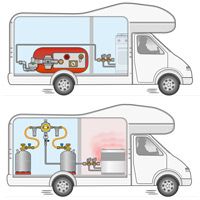LPG gas bottles types. Which ones are there?
In this article we tell you about LPG gas bottles and the different types such as; the material, type of gas tap and connections. We also explain the general operation and provide general safety advice. We will try to explain this step by step and illustrate it as best as possible. The associated topics are discussed further in additional posts.
This article has been removed and replaced by the tutorials below:
What is an LPG Gas Bottle and what different types are there?
The following related tutorials are associated with this article:
LPG installation in a recreational vehicle like a RV Camper, Caravan or Food Truck
LPG Vapor Tanks for RV Campers, Caravans and Food Trucks
Pressure Regulators for Gas Bottles and Vapor Tanks
Installation instructions for LPG cylinder tanks (vapor tanks) in (recreational) vehicles
The EN 1949 Standard: The European Standard for Safe LPG Systems in RVs and Caravans
What is an LPG Gas Bottle and what different types are there?



















































Comments
No comment at this time!
Leave your comment